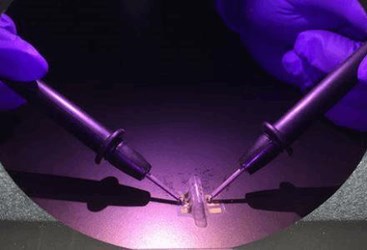Are Porous Polymers The Key To Non-Toxic Gold Circuits In Biomedical Wearables?

National Institute of Standards and Technology (NIST) researchers have uncovered a possible solution for incorporating non-toxic, but brittle, gold circuitry into sensing platforms that are flexible enough to be worn inside or outside the body for an extended period of time. Researchers found that, when integrating gold electrodes into a porous polymer membrane, the wires retained their conductivity without breaking down, even when bent or stretched.
Advances in sensing technology already have disrupted healthcare and the way clinicians approach chronic illness management, particularly as the system moves toward value-based care. Steve Messinger, president of ECG Management consultants, told the Washington Post that healthcare systems are under “intensified pressure to devise innovative care delivery strategies,” which includes advanced sensing and monitoring throughout the continuum of care.
Authors of a recent study published in Microsystems & Nanoengineering discussed the significant advances of sensing platforms over the past five years, and the challenges faced by researchers attempting to push forward with next-generation solutions. A key challenge, said the study authors, is creating a robust electrical system with biocompatible and flexible materials. The more stable the electrode, the more likely it is to be toxic and rigid.
Recent research demonstrates the promise of gold in biomedical applications, because it does not corrode like other metals, and it is non-toxic inside the body. Gold nanoparticles, in particular, have been used to advance a number of biomedical solutions, including biosensors, drug delivery, and cell monitoring. Sensors made from graphene and gold have been incorporated into a wearable patch developed by Korean scientists that monitors and manages diabetes.
Darwin Reyes-Hernandez, a biomedical engineer at NIST, notes that despite gold’s promise, applications using gold wires in wearable circuitry have been limited because of the metal’s tendency to crack and break down.
“Gold has been used to make wires that run across plastic surfaces, but until now the plastic has needed to be fairly rigid,” said Reyes-Hernandez in a press release. “You wouldn’t want it attached to you; it would be uncomfortable.”
While conducting research in microfluidics, Reyes-Hernandez found that gold electrodes embedded in porous plastic membranes retained their ability to conduct electricity, even when bent and stretched. The gold still cracked, but the damage was so tiny, the gold continued to conduct. Gold electrodes on non-porous polymers did not demonstrate the same result, a study published in Bioengineering & Translational Medicine showed. In fact, gold electrodes on the porous surfaces conducted better than gold circuitry attached to rigid surfaces.
Reyes-Hernandez concludes that this discovery could be a “major step” in wearable sensor research, adding that the super-thin and non-toxic membrane — an “almost one-of-a-kind material” — could fit into small, hard-to-reach spaces, an ideal attribute for biomedical applications.
